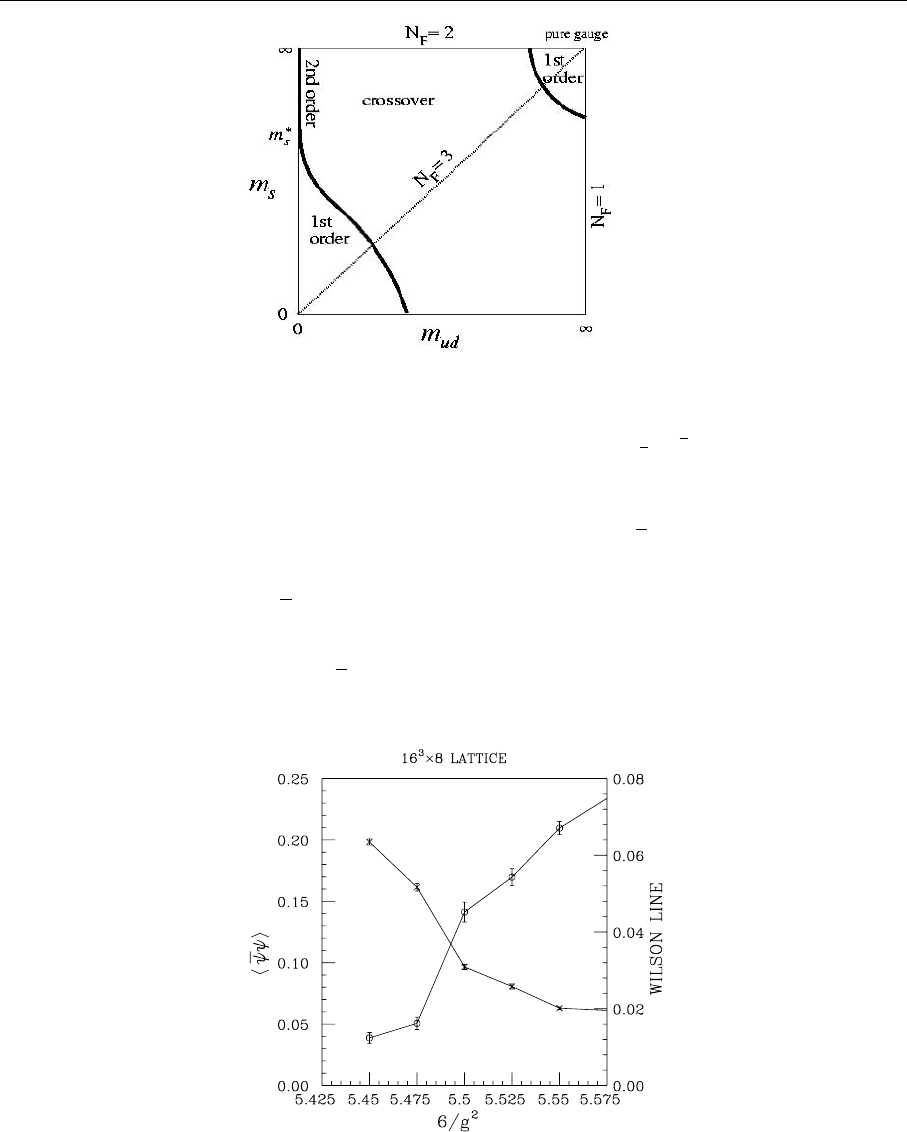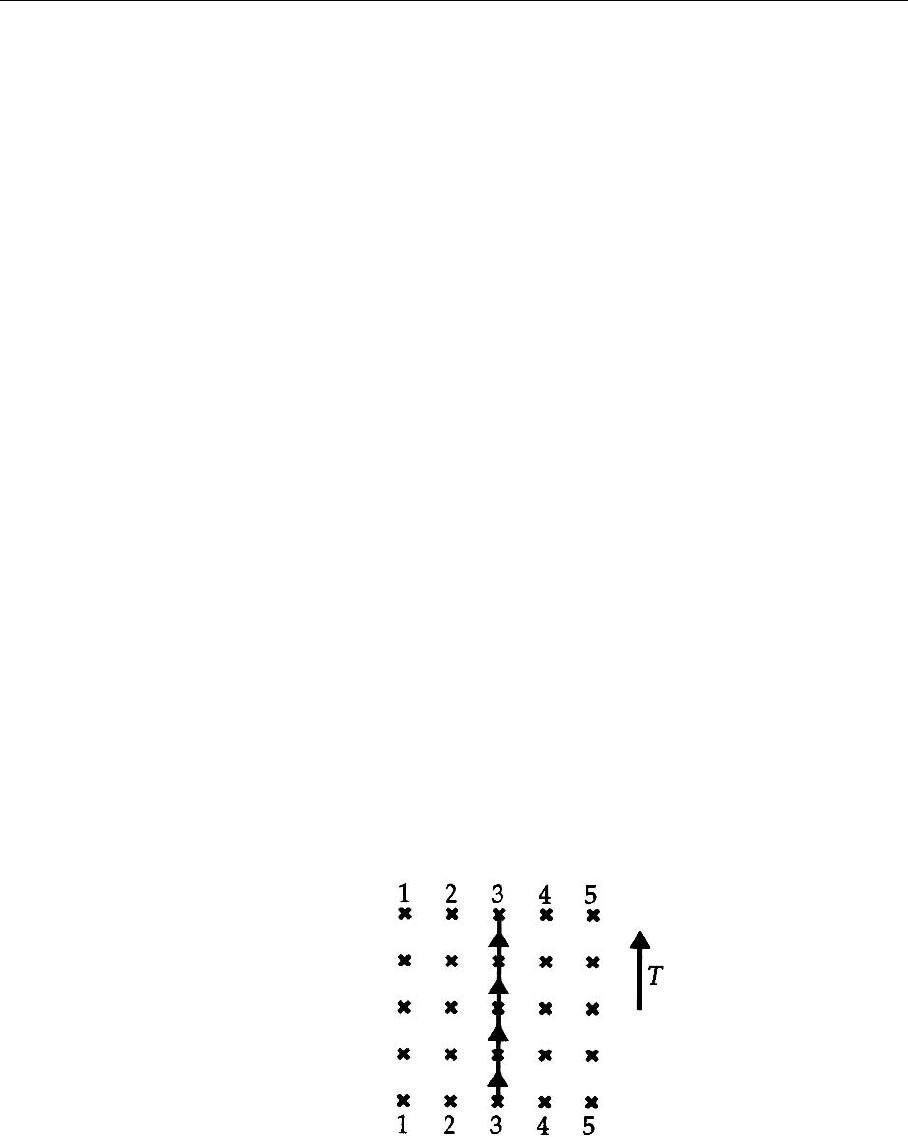Greiner W., Schrammm S., Stein E. Quantum Chromodynamics
Подождите немного. Документ загружается.


480 7. Nonperturbative QCD
where R is the distance between quark and antiquark. For simplicity, we do
not consider the color matrix structure of the fields in the following argument.
This does not change any results discussed here. We determine the quark–gluon
interaction term
j
µ
A
µ
= A
4
(7.163)
since the quarks are static. is just the color charge density, which reads
(x) = δ
(3)
(x) −δ
(3)
(x −R), (7.164)
where the positive charge sits at site x = 0 and the antiquark is put on a lattice
site with distance R =|R|. The action per time generated by this interaction is
S
E
=−i
d
4
x(x)A
4
(x) =−i
d
3
x(x)A
4
(x)
=−i
(
A
4
(0) − A
4
(R)
)
. (7.165)
As this result is time-independent, we can write
S
E
=−i
⎡
⎣
T
0
dτ
A
4
(0,τ)− A
4
(R,τ)
⎤
⎦
. (7.166)
If we assume that the time interval T is much larger than the distance |R|between
the quarks we can approximate S
E
by a closed-loop integration on the lattice:
S
E
T
|
R
|
≈−i
⎡
⎣
T
0
dτA
4
(0,τ)+
x=R
x=0
dsA( s, T )
+
0
T
dτA
4
(R,τ)+
x=0
x=R
dsA( s, 0)
⎤
⎦
=−i
C
l
dx
µ
A
µ
(x)
=T ·V(R). (7.167)
Now, looking back to our discussion of Wilson loops, a rectangular loop with
sides R and T (see Fig. 7.8)
w(R, T ) =tr
[
U
1
U
2
...U
N
]
(7.168)
is just the product of the link variables around the contour l. That is, in the
continuum limit we have
w(R, T )=
-
e
−ig
I
l
dx
µ
A
µ
(x)
.
= e
−T ·V(R)
, (7.169)

7.1 Lattice QCD Calculations 481
R
l
Fig. 7.8. The Wilson loop
to calculate the quark poten-
tial. A quark–antiquark pair
or their color fields, propa-
gate along the time links
where we have averaged over all possible gluonic configurations. As we dis-
cussed in the beginning, the assumption is that for large distances the potential
between quark and antiquark behaves like V
QQ
=σr.Fromthatweget
σ
R large,T Ra
=−
1
RT
lnw(R, T ) . (7.170)
In general the potential is similarly given by
V(R ) =−
1
T
lnw(R, T ) . (7.171)
Figure 7.9 shows the results of a lattice calculation of the potential. One
clearly recognizes the linear slope of the potential at large R. In fact, the total
Fig. 7.9. Lattice calcula-
tion of the quark–antiquark
potential. One can clearly
see the linearly rising po-
tential indicating confine-
ment (from: J. Garden et
al. (UKQCD collaboration):
Nucl. Phys. Proc. Suppl. 83,
165 (2000))

482 7. Nonperturbative QCD
potential can be fitted by the expression
V(R ) =−
α
r
+σr . (7.172)
Another related method to determine the string tension from the value of the
Wilson loops is to determine the so-called Creutz ratio Cr of loops:
13
Cr ∼ σ =−ln
w(R, T )w(R −1, T −1)
w(R, T −1)w(R −1, T )
. (7.173)
One can easily check that (7.173) will reduce to the value of the string tension
in the limit of large R and T :
Cr ∼−ln
'
e
−σRT−σ(R−1)(T −1)
e
−σR(T −1)−σ(R−1)T
(
=−ln
'
e
−σ(2RT−R−T +1)
e
−σ(2RT−R−T )
(
=−ln
e
−σ
= σ. (7.174)
The advantage of this expression is that finite-size effects due to the usually
rather small values of R , T in a realistic calculation can be suppressed by taking
ratios of observables.
7.1.16 The Lattice at Finite Temperature
One of the major research topics for lattice calculations, especially of QCD, is to
study strong interactions at finite temperatures (“finite” means larger than zero
here).
As we have discussed in the introduction to the path-integral formalism
(Sect. 7.1.1), a transition from real to imaginary time, i.e. an analytical contin-
uation into the complex t-plane, led us directly to the partition function of the
theory
Z(T, V ) = N
[dφ
i
]φ
i
|e
−βH
|φ
i
, (7.175)
where the initial and final states are identical.
In order to study vacuum properties one adopts the limit β →∞(or at least
very large in actual numerical calculations). It is now straightforward to study
finite temperatures within the same formalism. We just take a finite value of β =
1/T .
For imaginary times τ = it the time evolution operator and the Boltzmann
factor look alike
e
−iH(−iτ)
= e
−Hτ
←→ e
−βH
. (7.176)
13
M. Creutz: Phys. Rev. D 21, 2308 (1980).

7.1 Lattice QCD Calculations 483
This means that (7.175) can be seen as a transition amplitude for some finite time
interval T = 1/β. A finite extension in time together with periodic boundary
conditions has the consequence that the possible energy values ω
n
are discrete:
e
iω
B
n
T
= e
iω
B
n
0
−→ ω
B
n
=
2π
T
n , n = 0, 1,... . (7.177)
The ω
n
are the Matsubara frequencies, which are commonly used in finite-
temperature quantum field theory. Note that so far our discussion has not relied
on any lattice discretization and is also valid for the continuum theory.
For fermions there is the difference that one must assume antiperiodic
boundary conditions due to their anticommutation properties:
e
iω
F
n
T
=−e
iω
F
n
0
−→ ω
F
n
=
2π
T
n +
π
T
n = 0, 1,... (7.178)
N.B. As we have just discussed, the temperature of the system is equal to the
inverse length of the system in time direction. When one performs a lattice calcu-
lation the lattice necessarily has a finite size in the time direction due to the lack
of infinite computer power. This means there is always a temperature larger than
zero in every lattice calculation. So one has to ensure the temperature is kept low
enough by taking a big lattice so that the energy is much lower than the energy
of excited modes in the system.
In studies of finite-temperature properties of QCD matter, the values of the
energy density " and the pressure density P are of central importance. Let us
therefore outline how to determine " and P on the lattice.
Using the partition function Z we have
14
" =
T
2
V
∂
∂T
(
lnZ
)
V =const
,
P = T
∂
∂V
(
lnZ
)
T =const
. (7.179)
We see from these equations that we have to treat space and time separately in
order to keep V constant and vary T and vice versa.
There are actually two possibilities to vary T , for instance, as we discussed,
the temperature is given by the temporal extent L
t
of the lattice:
T =
1
L
t
=
1
N
t
a
, (7.180)
where N
t
is the number of points of the lattice in time direction. One can either
vary T by changing the lattice spacing a, or one could keep a but change the
number of points in the time direction. The latter method has the advantage that
it would change T without altering the volume of the system V = (N
x
a)
3
,which
is just what one needs in (7.179). There is a major disadvantage, however. N
t
is
14
W. Greiner, H. Stöcker, L. Neise: Thermodynamics and Statistical Mechanics
(Springer Berlin, Heidelberg 1995).

484 7. Nonperturbative QCD
an integer (in addition many lattice gauge codes require even values of N
t
), so
that the variation possibilities of temperature
1
N
t
a
−
1
(N
t
+1)a
≈
1
(N
t
)
2
a
=
T
N
t
(7.181)
is rather coarse. Therefore it is customary to stick with the former approach,
varying a. This one has its own problem since the volume would change too with
changing scale parameter. So we formally have to introduce two scales a
x
, a
t
for
the space and time directions (this is only needed to perform the derivatives; af-
terwards one can set a
x
=a
t
=a again). In this case one has to rewrite the Wilson
action (7.48) (including only gluons here):
S
W
=
β
x
r
P
x
1 −
1
3
Re trP
x
+rβ
t
P
t
1 −
1
3
Re trP
t
, (7.182)
where P
x
are plaquettes which lie in a plane with constant time, i.e. the (xy),
(xz),or(yz ) planes, whereas P
t
contains links in the time direction ((xt), (yt),
(zt) planes).
β
x
and β
t
are the inverse coupling strength defined via
β
x
=
6
g
2
s
(g
0
, r )
,
β
t
=
6
g
2
t
(g
0
, r )
, (7.183)
where the anisotropy factor is given by r =a
x
/a
t
.
The spatial and temporal coupling constants g
s
, g
t
generally depend on the
coupling g
0
, assuming an isotropic lattice r = 1, and the anisotropy in some com-
plicated fashion. In the isotropic limit r =1wehaveg
2
s
(g
0
, 1) = g
2
t
(g
0
, 1) = g
0
.
The factors r and 1/r can be intuitively explained by considering the follow-
ing argument. The volume element of the action a
4
becomes a
3
x
a
t
=r
−1
a
4
.The
spacelike part of the action is not further modified. The space–time plaquettes
contain two links in the time direction U
4
∼ e
i A
4
a
τ
. For small lattice spacing
1 −U is proportional to a
τ
compared to a
x
for spacelike links, altogether there is
an additional factor of r
2
for the contributions from P
τ
. Neglecting corrections
arising from g
2
s
= g
2
x
for r = 1, we now have the following expression for the
action:
S ∼rS
τ
+
1
r
S
x
+corrections , (7.184)
where S
τ
and S
x
contain space–time plaquettes P
τ
or space–space plaquettes P
x
,
respectively.
Using this result, we can return to calculate the energy and pressure of the
system. For the energy we get, using (7.179) and T = 1/(N
t
a
t
) =r/(N
t
a
x
),
" =
1
N
3
x
N
t
a
4
x
∂
∂r
ln Z(r)
r=1
. (7.185)

7.1 Lattice QCD Calculations 485
Fig. 7.10. Energy dens-
ity and pressure in a lat-
tice calculation including
the fermion determinant (for
2 flavors). The graph is
taken from C. Bernard et al.
(MILC collaboration): Nucl.
Phys. Proc. Suppl. 53, 442
(1997)
Using the definition of Z and the expression for the action (7.184) we get the
result
" =
1
N
3
x
N
t
a
4
x
G
−
∂S
∂r
H
r=1
=
1
N
3
x
N
t
a
4
x
S
τ
−S
x
+"
i
(7.186)
with
"
i
=
1
N
3
x
N
t
a
4
x
∂β
x
∂r
P
x
+
∂β
τ
∂r
P
τ
r=1
, (7.187)
where "
i
is the contribution to the energy arising from the dependence of the
coupling on a scale change, i.e. quantum corrections.
In Fig. 7.10 the results of a calculation of the energy and pressure on the lat-
tice as a function of temperature are shown. One can see a clear dramatic rise
in the energy density at a temperature of about 150 MeV, signaling a transition
from hadronic QCD states to a gaslike state, the experimentally much sought-
after quark–gluon plasma (QGP).
7.1.17 The Quark Condensate
Another order parameter which signals the phase transition is the quark conden-
sate
qq.Nowqq = q
L
q
R
+q
R
q
L
, where we have introduced the left-handed

486 7. Nonperturbative QCD
Fig. 7.11. A still much de-
bated problem is the order
of the phase transition to
the plasma phase. The fig-
ure shows a rough sketch
of the situation. For very
heavy or very light up,
down (m
ud
, horizontal axis)
and strange (m
s
, vertical
axis) quarks the transition
is presumably first-order.
The first-order regions and
the smooth cross-over re-
gion are separated by a 2nd-
order phase transition line.
In the range of the physi-
cal masses the result could
be first or second-order or
even a smooth transition be-
tween hadronic and quark
phase (from: K. Kanaya:
Nucl. Phys. Proc. Suppl. 47,
144 (1996))
Fig. 7.12. Lattice calcula-
tion of the Polyakov loop (or
Wilson line, which will be
explained in the following
section) and the chiral con-
densate as function of tem-
perature around the critical
temperature T
c
. The results
are taken from S. Gottlieb
et al. (MILC collabora-
tion): Phys. Rev. D 55, 6852
(1997)
(q
L
) and right-handed (q
R
) quark states, which are obtained by acting with the
projectors on states with definite handedness q
L
R
=
1
2
(1
−
+
γ
5
)ψ. The condensate
measures the amount of coupling between left- and right-handed particles in the
vacuum. Therefore it is also called the “chiral” condensate. Beyond a critical
temperature its value vanishes, signaling the transition to a state with (nearly)
massless quarks and gluons. On the lattice,
qq can be calculated as a path
integral of the trace of the propagator
qq=trG(x, x ) , (7.188)
using the master equation (7.23). Figure 7.12 shows the values of the Polyakov
loop and qq in a small temperature range around T
c
. One can observe the

7.1 Lattice QCD Calculations 487
interesting behavior (also seen in many other calculations) that the critical tem-
peratures for the deconfinement phase transition and the chiral transition seem
to be identical. This is a nontrivial result as both phenomena relate to differ-
ent physical effects. The theoretical explanation of this behavior is still under
discussion.
7.1.18 The Polyakov Loop
In Sect. 7.1.15 on the string tension we have shown how to extract the static
potential between quarks from the expectation of Wilson loops. There is an
alternative method to do this. As mentioned, it is crucial to construct gauge-
invariant quantities (if we do not want to fix the gauge on the lattice). Any
quantity with some unsaturated color indices like the untraced plaquette P
ab
will exactly vanish if we average it over all gauge rotations P
ab
=0. There is
a particularly useful type of gauge-invariant object we can specify on the lattice,
the so-called “Polyakov loop” (sometimes also called the “Wilson line”), given
by the following expression:
P(n) = tr
N
τ
;
n
τ
=1
U
4
(n, n
τ
). (7.189)
P(n) is defined at every space point and is the product of timelike links in the time
direction (see Fig. 7.13). Since we have periodic boundary conditions in the time
direction it forms a “loop” on the lattice. The trace guarantees gauge invariance:
˜
P(n) =tr G(n, 1)U
4
(n, 1)G
†
(n, 2)G(n, 2)U
4
(n, 2)G
†
(n, 3)...
G(n, N
τ
)U
4
(n, N
τ
)G
†
(n, Nτ +1)
=tr G(n, 1)
⎛
⎝
N
τ
;
n
τ
01
U
4
(n, nτ)
⎞
⎠
G
†
(n, N
τ
+1)
= P(n) (7.190)
because of the periodicity G(n, 1) = G(n, N
τ
+1).
Fig. 7.13. Graphical repre-
sentation of the Polyakov
loop. The links along the
time direction are multi-
plied, which yields a loop
structure because of the peri-
odic boundary conditions in
time

488 7. Nonperturbative QCD
The Polyakov loop has a rather simple physical meaning. If one considers an
infinitely heavy quark sitting at a given point x in space and only propagating in
the time direction, the Euclidean Schrödinger equation, ϕ
Q
(x,τ),isgivenby
∂
τ
ϕ
Q
(x,τ)= i A
4
(x, τ)ϕ
Q
(x,τ) . (7.191)
Thus we get a time-evolution operator S(τ) for the quark:
S(τ) = P exp
⎡
⎣
i
τ
dτ
A
4
(x,τ
)
⎤
⎦
. (7.192)
Expression (7.192) is just the continuum version of the Polyakov loop. It de-
scribes the propagation of a static color charge on the lattice. Thus calculating
the expectation value of the Polyakov loop at finite temperature T , one calculates
the partition function of the system Z
Q
including an open charge:
P(n)=Z
Q
=exp
$
−F
Q
/T
%
(7.193)
with the free energy of the system F
Q
. P serves as a signal for the deconfine-
ment phase transition. In the confinement phase, color charges cannot propagate.
Therefore, adding a color charge to the system by hand generates an infinite (or
very large, in the case of a finite-size lattice calculation) energy. Thus, according
to (7.193) the expectation value vanishes: P=0. However, beyond a critical
temperature one can observe a clear phase transition to finite values of P,sig-
nalling the possibility that open color charges can propagate. Figure 7.12 shows
the result of a lattice calculation. One can see that the Polyakov loop becomes
finite for temperatures T
c
∼250 MeV in a sharp transition that has been clearly
identified as a first-order transition. This is the result if one neglects the fermionic
determinant as discussed in Sect. 7.1.7. If the effects of quarks are included,
the temperature drops to T
c
∼140 MeV. Here the order of the transition is still
subject to debate.
7.1.19 The Center Symmetry
There exists an interesting symmetry of lattice QCD in connection with the
Polyakov loop. Take the link variables in a hyperplane for some fixed time, e.g.
n
τ
= 1. One might transform all timelike links in this hyperplane by a unitary
3 ×3matrix
ˆ
Z
˜
U
4
(n, n
τ
=1) = CU
4
(n, n
τ
= 1). (7.194)
Z belongs to the center of the gauge group, here SU(3). The center of a group is
defined as the class of elements C which leave all group elements invariant under
transformation, i.e. which commute with all group elements: [C, U]=0.

7.1 Lattice QCD Calculations 489
It is clear that C has to be proportional to the unit matrix in order to fulfil this
requirement
C = e
iα11
with α ∈[0, 2π] . (7.195)
In addition, SU(N) requires the determinant of the group element to be 1.
Therefore we get
det C = 1 ⇒tr α
11 =0mod2π, (7.196)
which yields
α
n
=
2πn
3
, n = 0, 1, 2 . (7.197)
The three elements C
1
to C
3
form an own group, the Z(3). In general, the Z(N)
group (replace 3 by N in (7.197)) is the group of discrete rotations around the
unit circle in the complex plane.
In the limit N →∞we get continuous rotations, which is just the usual U(1)
of electrodynamics, for instance.
From the definition of the action for the gluons, (7.48), we see that under
a transformation (7.195) the action does not change. Factors C only enter in the
S
τ
the part of the interaction containing space–time plaquettes. A plaquette in
the 41 plane, for example, is
P
41
=U
4
(n, 1)U
1
(n, 2)U
†
4
(n +ae
1
, 1)U
†
1
(n, 1). (7.198)
Transforming the links by using (7.194), we get
˜
P
41
=CU
4
U
1
U
†
4
C
†
U
†
1
. (7.199)
Since C commutes with all group elements one can shift C to the right and use
CC
†
= 1. Thus P
41
=
˜
P
41
.
Although the action is invariant under the center transformation, the
Polyakov loop is not, since it contains only one link belonging to the hyperplane
with n
τ
=1. There we have the transformation property
˜
P(n) =CP(n). (7.200)
As we have seen in the confined phase, P=0 because an isolated color field
is infinitely heavy. In the deconfined phase one can have P = 0. This is also
a signal of spontaneous breaking of the center symmetry: the system clusters
around one of the three values of C
n
,i.e.P attains the corresponding phase
factor e
i2πn/3
. Otherwise, an averaging over the values of C
n
C=0 would
again generate a vanishing Polyakov loop. This intimate relation between the
Z(3) structure of the Polyakov loops and the confinement/deconfinement phase
transition led to the idea that the critical behavior of the whole SU(3) theory can
be reduced to the one of a Z(3) spin model in three dimensions (as the Polyakov
loops P(n) are defined in three dimensions).
15
The fact that both systems exhibit
a first-order phase transition supports this idea.
15
See B. Svetitsky, L.G. Yaffe: Nucl. Phys. B 210, 423 (1982).
